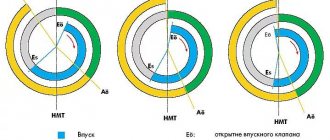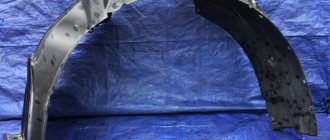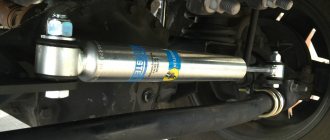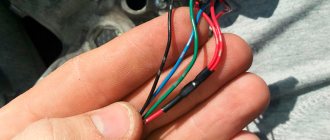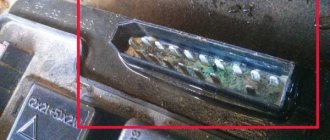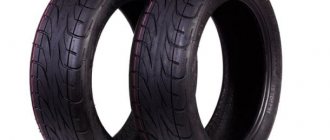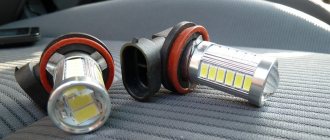Published:
26.05.2016
For many car enthusiasts, the phrase “steering damper” is mysterious and unfamiliar. This is not surprising. Not every car owner encounters such a mechanism in his driving practice and has no idea what this device is for. Why? Yes, because this device is simply not installed on a huge number of machines.
Let's face it, not every vehicle needs it either. However, let's figure out what this unpopular, but nonetheless useful device is.
How to install a damper on a car
Before describing the damper installation procedure, it is advisable to say a few words about its design features. So, the standard device consists of the following elements:
- two chambers, which are separated from each other by a partition;
- small container with oil;
- adjustable valves;
- special spring (for certain models);
- fastening elements.
From everything described above, it becomes obvious that there should be no difficulties in attaching the damper. True, in some cases you will have to show some ingenuity. An important point is the ability to adjust the device for a specific type of car and load (vibration), which will need to be “pacified” in the future.
The most common way to enhance steering is by using a damper. To do this, one end of the device is rigidly attached between the steering rods, and the other is secured to the frame or body of the car.
When choosing an installation location, it is important to consider that the shock absorbing parts must have a minimum level of movement relative to each other
This is important because of the design features of the damper, which itself is quite rigid, and if you try to stretch it in the other direction, you may have the opposite effect when the vibration damping device resists during long turns and involuntarily pulls your steering in the opposite direction . It must be remembered that choosing the right damper depends on the type, weight, design of the vehicle, further loads that the vehicle will experience, as well as its operating conditions
Typically, the devices have a universal shape and size, which allows them to be freely attached to virtually any car. But due to the different levels of resistance to vibrations and the possibility of absorbing them, it is important to determine exactly what is suitable in your case, so as not to get the opposite effect
It must be remembered that choosing the right damper depends on the type, weight, design of the vehicle, further loads that the vehicle will experience, as well as its operating conditions. Typically, the devices have a universal shape and size, which allows them to be freely attached to virtually any car.
But due to the different levels of resistance to vibrations and the possibility of absorbing them, it is important to determine exactly what is suitable in your case, so as not to get the opposite effect
Share information with friends:
Installing a damper on a UAZ Patriot. How to do it? review
There is a design flaw, which is usually eliminated with the help of a damper (from the English word damp, which means to extinguish). Thus, as the name implies, the device is designed to dampen vibrations and eliminate yaw.
Installing a damper on a UAZ Patriot
not such a difficult matter. And in some car dealerships they offer to buy the spare part along with the car (they also install it there for completely additional money). But if you didn’t plan to pay above the limit (or simply bought a used one without the described part), then you can successfully install the damper yourself.
Device Description
By its nature, the damper uses the principle of a shock absorber. It is known that such vibration in the steering wheel occurs during country travel on Russian broken dirt roads and field roads. And Patriot owners oh, how they love this thing - driving over rough terrain. After all, the car is not a city car at all! Whatever you say, this is one of the best SUVs for Russia.
Result:
When driving like this, the vibration goes off scale so much that sometimes it is difficult for the driver to hold the steering wheel. The damper, of course, does not save completely. It only eliminates the possibility of yaw during vibration, dampening it.
If we ignore the nuances, the damper consists of a cylinder that contains a piston and lubricant, which tries to return the part to its original position. A spring is also installed before the one-way device, which performs the tasks of reverse movement.
Application
Hydraulic and pneumatic dampers are used in hydraulic systems, automatic regulators and measuring instruments. Hydraulic dampers are divided into pulsation dampers, flow stabilizers, pulsation dampers and water hammer dampers. Also, to varying degrees, standard piston, balloon and diaphragm accumulators are used as hydraulic dampers.
In electrical machines, a damper (damper winding) is an inductor that prevents a sharp increase in switching currents or voltages in electrical circuits; for example, in the event of a short circuit or interference.
In stringed musical instruments, a damper is a device for stopping string vibrations, consisting of separate blocks (for a piano) or strips (for a harp), covered with soft felt (filt).
Suspensions of cars and other vehicles use damping devices called shock absorbers.
In acoustic systems (so-called “speakers”), a damper is a rim that secures the membrane of the sound element to the frame. Usually made from polymer materials (for high-frequency elements), rubber or foam rubber (for mid- and low-frequency elements). Used to dampen residual vibrations of the membrane.
In aviation: aeroelastic oscillation damper of an aircraft is an independent on-board electronic system or subsystem as part of an automatic flight control system (ACS), designed to automatically dampen short-period oscillations of an aircraft in flight, which inevitably arise when flight conditions change and, most importantly, to prevent involuntary rocking of the aircraft by the pilot, which can lead to significant overloads and structural failure. In technical terms, it consists of a group of gyroscopic sensors that control the angular movements of the aircraft in space, an electronic circuit for processing and amplifying damping signals and actuators connected in series to the mechanical control wiring, or these signals are mixed with other ACS control signals
The problem of longitudinal progressive swing was acutely manifested on the supersonic bomber Tu-22, for the same reason the experienced Su-27 was lost. The problem of lateral movement is still relevant for almost all heavy (including passenger) aircraft, and is referred to as the “Dutch step”. Almost all large passenger aircraft have automatic damping.
- In risk management, a damper
is a threshold value of safe risk for an enterprise. The risk damping mechanism involves analyzing possible threats or factors that give rise to these threats, determining security thresholds, and identifying the range of conscious risks that an economic entity is ready to take. - In programming, a damper
is a system for balancing the load on system components during surges in the data arrival rate.
Engine damper
Engine damper and its installation
Installing it, in fact, is not very difficult. One end of the damper is attached to the car body, and the other to the engine. But how to secure it is already a question.
Therefore, first we will look at the fastening of the damper, intended for installation only on Mazda 3 cars. The damper kit for this car includes the shock absorber itself, a mounting bracket installed on the engine, a mounting ring for the body, bolts and studs.
Installation is not particularly difficult. All this will be mounted in the engine compartment on the right side in the direction of travel.
The mounting ring has a special shape for installing it on the body at the attachment point of the front pillar. To install the ring, just unscrew the rack mounting bolts and place the ring so that the holes in it coincide with the rack mounting holes. Then the bolts need to be installed in place and tightened.
The mounting bracket is fixed to the engine, on the platform below the oil filler plug. To secure it, use the studs included in the kit.
Then a damper is installed between the fasteners and secured with bolts. At this point, the installation of the vibration damping device on the Mazda 3 can be considered complete.
This element is somewhat more difficult to install. If it is universal and does not have special fastenings.
The damper can be installed relatively easily if the car has a suspension strut running under the hood. It is to this that one end of the damper can be attached.
To attach to the engine, it may be necessary to manufacture a mounting bracket. The main thing is to choose the right mounting location. You can press the manufactured bracket with some engine bolts. In general, here it is already a matter of choice for the car owner himself.
If there is no spacer, some people make their own mounting ring to the car body. In general, the mounting method is not particularly important, the main thing is that one end of the damper is attached to the body, and the other to the engine.
How much additional damping is needed?
Let us immediately note that this equipment is optional; its installation on the vehicle is not required. It is positioned as a means of increasing the comfort of being in a car, helping to reduce driver fatigue (if it is a mini steering shock absorber) and reducing the load on the engine (engine vibration damper). One can note more even wear on the tire tread and better grip on the road surface, but all these “goodies” are more cosmetic than real.
So the question of how necessary such an element is remains open - each car enthusiast must decide for himself how much he will gain compared to what he will lose.
Advantages and disadvantages of auto dampers
If you have not yet decided whether you need such a device or can do without it, you should familiarize yourself with their advantages and disadvantages.
Let's start with the pros:
- significant shock mitigation. The wheel axle is the first to take on the load when hitting road irregularities, but standard shock absorbers do not cope with their task completely and not always. A modern damper reduces the vibration force by about 30%, both in relation to the steering wheel and in relation to the engine. Obstacles such as tram tracks, slab joints, wide cracks in the road surface, and even speed bumps will be overcome much more smoothly;
- Suspension knocks are always an unpleasant sound. Steering/engine dampers allow you to get rid of it, if not completely, then significantly;
- Vibration of a car during heavy braking is also not a pleasant phenomenon, as is the case when accelerating above 100 km/h. It is also worth mentioning a similar phenomenon with deformed disks, in the absence of proper wheel balancing. Additional shock absorbers will eliminate this problem;
- A steering damping device can improve vehicle handling when driving at above-average speeds.
But this node cannot be called ideal either, and here’s why:
- When installing a damper on the steering wheel, at first you will have to get used to the “wobbiness” of the steering wheel, and it is far from a fact that you will come to terms with it;
- the same can be said about the effort applied when rotating the steering wheel.
However, according to a statistical survey, over 80% of drivers who have installed additional shock-absorbing units on their cars are satisfied with their performance.
At the same time, there is a risk that you will fall into the opposite camp - every fifth car owner either did not feel the difference before and after installing the damper, or was dissatisfied with its performance.
Purpose and benefits
Such a tiny structural detail plays an important role in ensuring comfort when using cabinet doors and cabinets. It is for this reason that it is worth learning more about the varieties of this furniture fittings.
Dampers are various types of parts that can soften the contact of two surfaces.
In other words, even an ordinary rubber gasket can be called this. If we are talking specifically about a furniture device, then it has some features in its structure and use.
In practice, the damper is a special part required during assembly. This is a kind of shock absorber that will allow a furniture facade that opens upward to be fixed in the open position. In this case, you do not need to additionally hold the door with your hand to get the contents of the shelf, which is very convenient.
Of course, this is far from the most innovative fittings. It was invented quite a long time ago, but nowadays manufacturers are improving the creation of this part in order to make products as functional, practical and durable as possible.
There are several options for dampers, the simplest of which is self-adhesive. It is a disk with a diameter of 7-10 mm and a thickness of 1.5-2 mm. It is made of soft material that perfectly dampens the sound from the closing door. This type has an adhesive layer, making it very easy to stick to the end of the cabinet. It is worth noting that this is the most common way to fix the door slamming problem.
Compared to closers
Strictly speaking, shock absorbers partially perform the function of a closer. They only dampen the impact, making the closing of the facade silent. The hinge itself reaches the closing position of the door.
Considering this fact, it would be fair to mention those dampers that have nothing to do with hinges, but functionally play the same role as overhead door closers and shock absorbers - they dampen the impact of the door on the body when closing the facade.
Steering damper
Installing the steering damper
Such devices can also be sold as a kit with all fasteners. But some people simply purchase a damper from Mercedes Benz and install it on their car.
This is located along the steering mechanism. As in the case of the engine damper, one end of it is attached to the body, and the other is attached directly to the mechanism at the point where the rods are attached to the rack.
Some versions come complete with a special spacer, making the structure more rigid and reliable.
Let's look at how to install a damper from Mercedes Benz. So, there is only a damper, but you need to provide mounting points for it.
To do this, you need to unscrew the steering gear mounting bracket, the one closest to the expansion tank. Next, a plate with a hole for attaching the damper is welded to this bracket.
Something else useful for you:
- Reasons why the shock absorber knocks
- MacPherson suspension - design, principle of operation, advantages and disadvantages
- How to choose the right shock absorber for a car
Video: Installing a Damper on a UAZ Patriot
https://youtube.com/watch?v=yGliSjVdfqg
Then you will need an adapter to attach the damper to the mechanism rack. To do this, a plate shaped like a heart is cut out of metal.
Three holes need to be drilled in this plate. Two should coincide with the holes for attaching the rods to the rail. Below these two holes there should be another one - for attaching the damper.
After this, you can begin assembly. First, the mechanism fastening bracket is installed, and the end of the damper is already attached to it.
Then you need to unscrew the bolts securing the rods, press the prepared adapter to the rods and screw the bolts back. Then the other end of the damper is screwed to the adapter.
If you purchase a kit that includes a special spacer, then installing everything will not be difficult at all.
In this kit, in addition to the damper itself and the spacer, there are also brackets for fastening the mechanism, but modified to install a spacer and a vibration damping element. Usually the kit also includes an adapter.
All that remains for installation on the steering mechanism is to remove the factory mounting brackets and install them in place that come with the kit.
Then the spacer is installed and secured. All that remains is to secure the adapter and install the damper.
All this work is not so complicated, but the benefits of using dampers are significant. Car owners who have installed an engine damper note a decrease in vibration of the power plant, and gear shifting becomes “clearer”.
As for the steering dampers, it is noted that impacts from the wheels on the steering wheel are softened, vibration of the steering wheel during braking is reduced, and knocks from the suspension are reduced.
Damper: what is it in a car
Many of you have heard about steering dampers, which are installed on two-wheeled vehicles - motorcycles and bicycles .
We will talk about their use in cars, where this device brings no less benefits.
What is a steering damper
Most older cars have one thing in common - unstable handling. Small parts in the suspension and steering can wear out over time, causing the steering wheel to vibrate constantly. Installing a steering damper or replacing it in a timely manner will help get rid of this problem.
This part works as a shock absorber for your car's steering system. Bumps in the road transfer vibrations from your car's front wheels to the steering mechanism, causing the steering wheel to shake.
The damper absorbs and disperses vibrations to help you enjoy smooth steering.
Where is it used?
A steering damper, also known as a steering stabilizer, is installed in a vehicle between the steering linkages and the chassis. Acting as a shock absorber, it suppresses movement and vibration from driving over bumps and potholes from the steering wheel. Like shock absorbers, a steering damper loses effectiveness with prolonged use and eventually breaks. Signs of damper damage can be misleading because they are similar to the usual signs of suspension damage: difficult steering and uneven steering angles.
If you do not replace the damper in time, you will not be able to handle the steering wheel easily. To avoid unnecessary hassle, replace your faulty steering damper as soon as you can.
Advantages and disadvantages
The main advantages of the steering damper:
— Makes driving easier and more convenient - instead of struggling with constant vibrations on the steering wheel, you simply drive the car;
— Helps maintain correct wheel alignment angles longer;
— Tire wear becomes more uniform due to their better adherence to the surface;
— Easy to install - even if your car has not been equipped with a steering damper before, you can easily select and install it yourself.
Disadvantages of a steering damper:
- Reduced steering sharpness - some car owners complain about this drawback, but it does not always occur;
— Reduced steering information content - due to smoothing and absorbing irregularities in the steering wheel, it is more difficult to determine what surface you are moving on and at what speed.
What cars are equipped with a steering damper?
There are practically no contraindications for installing a steering damper. First of all, owners of old cars with high mileage should think about installing a steering damper, the suspension of which can no longer cope with the loads from road irregularities and transmits vibrations from them to the steering wheel. In this case, the steering damper will take on part of the work of the suspension to dampen unnecessary vibrations.
But steering dampers are the most popular among owners of SUVs, especially those made in Russia. Installing a damper significantly improves handling on any type of surface - impacts from large stones, bumps, and potholes will no longer be completely transmitted to the steering wheel, which, in turn, will not be pulled out of your hands. In this case, the damper becomes an additional suspension assistant.
The benefits of installing a steering damper will also be felt by owners of new passenger cars, especially those who often drive outside the city, on secondary roads or on roads without asphalt. Driving your car will become noticeably easier, tire wear will become more even, and fatigue from driving will be significantly reduced. Please note that many modern cars have a steering damper installed at the factory. Moreover, it may not necessarily have a familiar appearance and be a separate detail.
How to install a steering damper
Driving a car, even under normal everyday conditions, can be uncomfortable without a working steering stabilizer. Check your vehicle's owner's manual to determine which damper to use to replace the old one.
Below are step-by-step instructions on how to install a steering damper.
Step 1 - Preparing the Vehicle
Your car will need to be raised so that you can access it from below. The front wheels should be straight to make the job easier. On some vehicles the damper can be removed and replaced without the use of lifts. You can access it through the engine compartment . Regardless of where the steering damper is installed, the basic setup remains largely the same.
Step 2 - Remove Existing Damper
The existing damper would likely be located on the passenger side next to the coil spring . Remove the bolts holding it on both ends. There may also be a cotter pin that needs to be removed as well. Before installing a new damper, clean the installation area from accumulated dirt.
Step 3 - Installing the Damper
Now you can begin installing the new damper. Place it on the mounting bracket near the coil spring and tighten the mounting bolt. Tighten without applying too much force until the other side is joined. You can use the old bolt or a new one if it was included with the steering damper kit.
You will need a torque wrench for final tightening. Install the bolt at the other end into the hole in the tie rod. Once it is installed, you can tighten the bolts completely. Always check the operating instructions to ensure that each bolt is torqued to the correct torque. It will vary between the two bolts.
Step 4 - Cotter Pin
You will see a hole in the bolt and a notch in the nut. Turn the nut far enough to align them. Take the pin that was provided in the kit and insert it into this hole. Using pliers, open the cotter pin and turn it if necessary. Your new steering damper should now be fully installed. Now you will regain lost control and your steering wheel will not pull out when you drive over bumps and potholes.
If you are installing a steering damper on a car that has not previously been equipped with one, pay attention to the following.
Typically, the damper is installed between moving (steering rods) and fixed (body, frame, bridge) elements. In this case, their movement relative to each other should be minimal. Otherwise, the hard damper will attract the steering rod to the body and when hitting bumps, the car itself will steer to the side. Also, the steering damper should not limit the maximum steering angles.
The damper is installed in such cases using metal corners welded at the mounting points, or using special clamps included in the kit. The method and location of attachment must be chosen very carefully; incorrect installation will lead to deterioration of the vehicle's performance, and the damper simply will not do its job and will quickly fail.
Subscribe to our feeds on social networks such as , , Instagram, Pinterest, Yandex Zen, and Telegram: all the most interesting automotive events collected in one place.
Source: https://auto.today/bok/1309-dempfer-chto-eto.html
Steering damper
What is a steering damper for? The reasons are the same: dampening the shaking of the steering column when driving over uneven roads. Such a buffer device is capable of effectively absorbing both vibrations and shocks, which are transmitted to the steering thanks to its rigid connection to the vehicle’s suspension. The looser the steering wheel, the more noticeable the vibration and shocks are on the fingers and hands holding the steering wheel. The steering damper is able to cope with this problem.
The secondary function of such a device is to return the steering wheel to the zero position, which helps maintain a straight trajectory of the vehicle. It is after falling into holes that the car usually goes off the track. The damper in this regard simplifies the driver’s task, but at the same time, without the presence of power steering (regardless of the type), quickly turning the steering wheel will definitely become more difficult.
As in the case of a damping device for the power unit, the steering vibration damper is structurally a smaller copy of the shock absorber. If it is a single-acting device, it is usually equipped with a spring. When assembled, such a kit resembles a shock absorber strut, but with much smaller dimensions.
The target audience for the steering damper is clear - these are cars that often drive on frankly bad roads (a fair question arises, where are our good roads?). Jeeps and other fairly heavy vehicles are characterized by increased hand fatigue, so for these categories of vehicles, steering shock absorbers will also be useful.
What is a steering damper used for?
photo: uaz.ru
Thus, the steering damper can be thought of as a kind of shock absorber operating in a horizontal plane (which it is from a technical point of view). But why is it needed?
In particular, if we take the main purpose of using a horizontally located damping element, we can say the following: the main purpose of the damper is to dampen unwanted vibrations of the steering elements, which can greatly interfere with the control of the car due to the accumulation of driver fatigue, and also affect the wear of suspension elements and steering, as well as other parts of the car, in particular tires.
Its use is especially relevant on uneven surfaces, which, when the car passes them, respond by twitching and moving the steering wheel from side to side. The driver has to fight with them, often jeopardizing the safety of driving the car.
Also part of the work of the steering damper is to return the steering wheel to its original position in order to keep the car in a straight line.
But, perhaps, the most important part of the damper’s work is to increase the vehicle’s directional stability when driving on asphalt roads and to avoid such a phenomenon as shimmy (also known as wobbling, in slang - “sausage”) - spontaneous vibrations of the front wheels when steering, arising from - for fastening play, deformation of the wheel support and lateral vibrations of the vehicle - a negative and extremely dangerous phenomenon:
Video taken from YouTube channel “Rare Parts Inc”
As you can see, with this phenomenon, the wheels, steering, and suspension begin to move uncontrollably in a horizontal plane, increasing their amplitude and trying to turn the car around its axis. It is almost impossible to drive a car in such a state.
The shimmy phenomenon is caused when hitting an obstacle or after one of the front wheels falls into a hole. The installation of a steering damper, also called a shimmy damper, can eliminate or minimize the negative behavior of the front suspension. It is this that will dampen all vibrations that will subsequently arise between the steering rods and the bridge.
From here you can draw several important conclusions so that your SUV does not end up in such situations:
1
It is important for jeepers to monitor the health of the front suspension and steering; 2
Monitor the serviceability of the steering damper;
2. Monitor the serviceability of the steering damper;
3. Do not make unauthorized changes to the steering elements and suspension of the car (tuning).
Who needs a damper
The ability of the mechanism to reduce the level of steering wheel vibrations, adjust control and, therefore, reduce the physical and psychological stress of drivers is quite useful. However, adding such an element to the design is not advisable for every car.
Installation of a steering damper occurs when operating heavy specific equipment, large SUVs and sports cars. The damper is designed to make it easier and more comfortable to drive the machine in extreme conditions such as rocky soil, holes, puddles, mud and other “joys” typical of rough terrain.
Passenger cars designed to travel along paved concrete jungle paths do not need such modification.
Engine damper
A damping device for damping vibrations of a power unit first appeared in tuning studios as one of the important attributes of sports cars. But, as often happens with many innovations used in motorsports, they gradually migrated to production cars. Today this is still a rarity, but finding a motor damper in the most seedy auto shop is no longer a problem.
It is well known that vibrations with maximum amplitude on the engine occur during gear shifts. This behavior is especially typical on high-speed engines installed in luxury and sports cars. This is largely facilitated by the aggressive driving style, when a sharp change in the amount of torque is followed by a “sharp” pressing of the clutch and an equally rapid gear change. The result in most cases is a very noticeable and at least unpleasant jerk. On a regular car in city mode, such switchings are rare, but on the race track this is quite an ordinary occurrence. Standard pillows are powerless against it, regardless of their design. In addition, frequent jerks accompanied by shaking provoke accelerated wear of the pillows. An engine damper helps to avoid all these troubles.
So if you are asked what an engine damper is, you can safely answer: it is a miniature additional shock absorber that functions exactly like its larger brother, and is tailored specifically for the power unit. That is, vibration damping occurs due to the fact that the rod, together with the upper mount, moves in a chamber filled with oil under decent pressure, according to an inverse exponential relationship: first quickly, and then rapidly slowing down.
The principle of installing engine dampers is the same for all models, although the size and shape of the mounts are slightly different. Typically, these devices are attached to the studs of the body cups, at the location where the support bearing is mounted. The upper end of the damper is fixed to the block, most often in the area of the pillow.
When purchasing such a mini-shock absorber, you should take into account that they are manufactured focusing on a specific model or series, which allows you to take into account the parameters, shape, dimensions and features of the location of the motor. But you can also find universal products equipped with adjusting bolts that allow you to customize the damper to suit your needs.
Since installing a damper assembly is a one-time operation, it is best to do this at a service station. But if you want and have the appropriate skills, nothing prevents you from doing it yourself. The degree of rigidity is adjusted after installation in accordance with the individual preferences of the driver. The installation task is simplified if the kit includes fasteners - such kits are not uncommon.
How necessary it is to install a damping device on your car is up to you to decide. If the problem of vibrations practically does not bother you, if you are not a fan of tuning for the sake of tuning, then you shouldn’t bother buying and installing it. But when you often travel off-road, it’s worth considering.
Installing a damper on a UAZ Patriot. How to do it? + review
Download PDF
Why is it so necessary to install a damper on a UAZ Patriot?
According to statistics, the vast majority of happy owners of these SUVs note a decrease in vehicle controllability when driving on unequipped roads: vibration, steering wheel beating. And at acceleration of 70+, they observe the so-called yaw and further deterioration in the car’s handling. There is a design flaw, which is usually eliminated with the help of a damper (from the English word damp, which means to extinguish). Thus, as we can see from the name itself, the device is designed to dampen emerging vibrations and eliminate yaw.
Installing a damper on a UAZ Patriot is not such a difficult task. And in some car dealerships they offer to purchase the spare part along with the car (they also install it there for completely additional money). But if you didn’t plan to pay above the limit (or simply bought a used one without the described part), then you can successfully install the damper yourself.
Device Description
By its nature, the damper uses the principle of a shock absorber. It is known that such vibration in the steering wheel occurs during country travel on Russian broken dirt roads and field roads. And Patriot owners oh, how they love this thing - driving over rough terrain. After all, the car is not a city car at all! Whatever you say, this is one of the best SUVs for Russia.
Result:
When driving like this, the vibration goes off scale so much that sometimes the driver can hardly hold the steering wheel. The damper, of course, does not save completely. It only eliminates the possibility of yaw during vibration, dampening it.
If we ignore the nuances, the damper consists of a cylinder in which there is a piston and lubricant that tries to return the part to its original position. A spring is also installed on the one-sided device, which performs the task of return movement.
Installing the damper
The main thing, probably, during installation is to ensure that the axes of the device body and the steering rod itself coincide. The smaller the angle of divergence of the axes, the longer the device will function. And since the fastening occurs with the help of silent bands, they will quickly fail if the angle is incorrect. Incorrect alignment of the axes impairs the mobility of the steering device (especially if there is no power steering) and the maneuverability of the car due to the leisurely reaction to turning the steering wheel in the driver’s hands.
This feature sometimes complicates repair work. You will also need a welding machine for installation, keep this in mind.
The next step is choosing:
where to install. As a reminder, Russian SUVs have paired steering rods. The question arises: on the top or on the bottom? Here the opinions of experts differ. At the bottom, this device, of course, plows with maximum effect and impact. It will make little adjustments to the car in urban travel and use. But when racing over bumps and potholes, the damper with lower thrust is subject to maximum damage and injury.
Sometimes this installation option is used:
The damper is fixed between the steering wheel and the frame or axle. This one is less successful, since when driving with obstacles the device will constantly adjust the traction due to the return movement of the damper.
After choosing a location, we begin the installation. We weld the corner with the fastener (hole). We attach a similar corner to the steering rod. We check that the device does not limit the steering angle from one side to the other.
We install the damper so that it is parallel and the axes coincide.
We tighten and check the steering movement.
Installing a damper on a UAZ Patriot can be done without a welding machine. Here the installation is already carried out using clamps, put on and adjusted. Such a device (with detailed instructions included) is even easier to install yourself.
Where is a damper used?
The most common use of dampers can be seen in the process of strengthening the protection of engines and steering systems.
It is in these places that the presence of additional vibration causes an increased level of discomfort. You need to understand that on modern sports or high-speed cars, the presence of dampers is provided structurally. But this does not mean that this device cannot be installed on a vehicle of another model.
It is important to understand here that the damper is technologically compatible with almost all types of cars. True, you will have to tinker a little with the fastenings, up to a small constructive intervention, in the form of welding special fastening brackets to the bottom or body, to which the damper will be attached
It should be noted that dampers are supplied with a minimum required set of fastening elements, which greatly simplifies the search for the necessary parts for their installation and fastening.
Now a little about when you should use a damper on cars. Of course, if the road is smooth, there are no potholes, and there are no various excess loads on the car. The role of the damper will be reduced to a minimum during car operation, so its use may not even be advisable. But if you are constantly driving on uneven terrain, where the car is subjected to tests of stability and structural strength, the occurrence of excessive vibrations is common.
It is in this case that the damper will be the ideal solution to reduce (and in some cases become the basis for its complete absence) the impact of vibration on the car body and on the steering. As a result, the driver, holding the steering wheel, will not feel hesitation, and during turns, the feeling that the steering wheel is not listening to you, or the wheels are turning in the other direction, will also not appear.
Damper devices are ideal for SUVs of various types and models, as well as vehicles that most of the time travel on country roads or roads with damaged surfaces.
Steering damper: why is it needed and how to install it. Cost and selection criteria
Not many people know what a steering damper is. Let’s say, many people don’t even need it! Apparently, therefore, this is not such a common and mandatory element in the steering of a car. In this article we will try to lift the curtain on what cars steering dampers are usually used for, what are the accepted rules for installing them and how much they generally cost.
What is an engine vibration damper?
An engine vibration damper, or simply an engine damper, is a relatively new invention in the world of auto tuning. As a rule, such “tricks” are found on sports cars, but, like all other “bells and whistles” borrowed from motorsport, engine dampers have successfully “migrated” to production cars.
The largest engine vibrations occur during gear changes on high-speed engines of sports cars or cars “tailored” for sports. During a sharp change in torque and “sharp” clutch, the jerk when changing gears is quite serious and very noticeable by the driver. One or two of these jerks can be tolerated, but if it happens constantly, a drastic solution is needed. In such situations, engine mounts are either powerless or do not completely absorb vibrations and shocks; in addition, due to strong jerks and impacts, the mounts fail much faster.
As you can see, there are more than enough reasons to install an engine damper, provided that its installation is really justified, and the one who installs this part really understands what it is for and needs it. The dampers themselves are a miniature shock absorber that works on the same principle , like shock absorber struts, dampens vibrations through the tight movement of the rod in a chamber that is under high pressure and filled with oil. The principle of attaching engine vibration dampers is basically the same for all, the configuration or dimensions of the mounts may differ, but the attachment points, as a rule, are the same for all. The engine dampers are attached to the studs of the body cup in which the support bearing is installed, and the second end is attached to the engine block (for example, to the engine mount) or one of its elements. As a rule, dampers are made for a specific engine model, taking into account the characteristics of the motor, as well as the strength and amplitude of its vibrations. However, there are also universal engine vibration dampers, which can be adjusted, as they say, “to suit you” using adjusting nuts.

